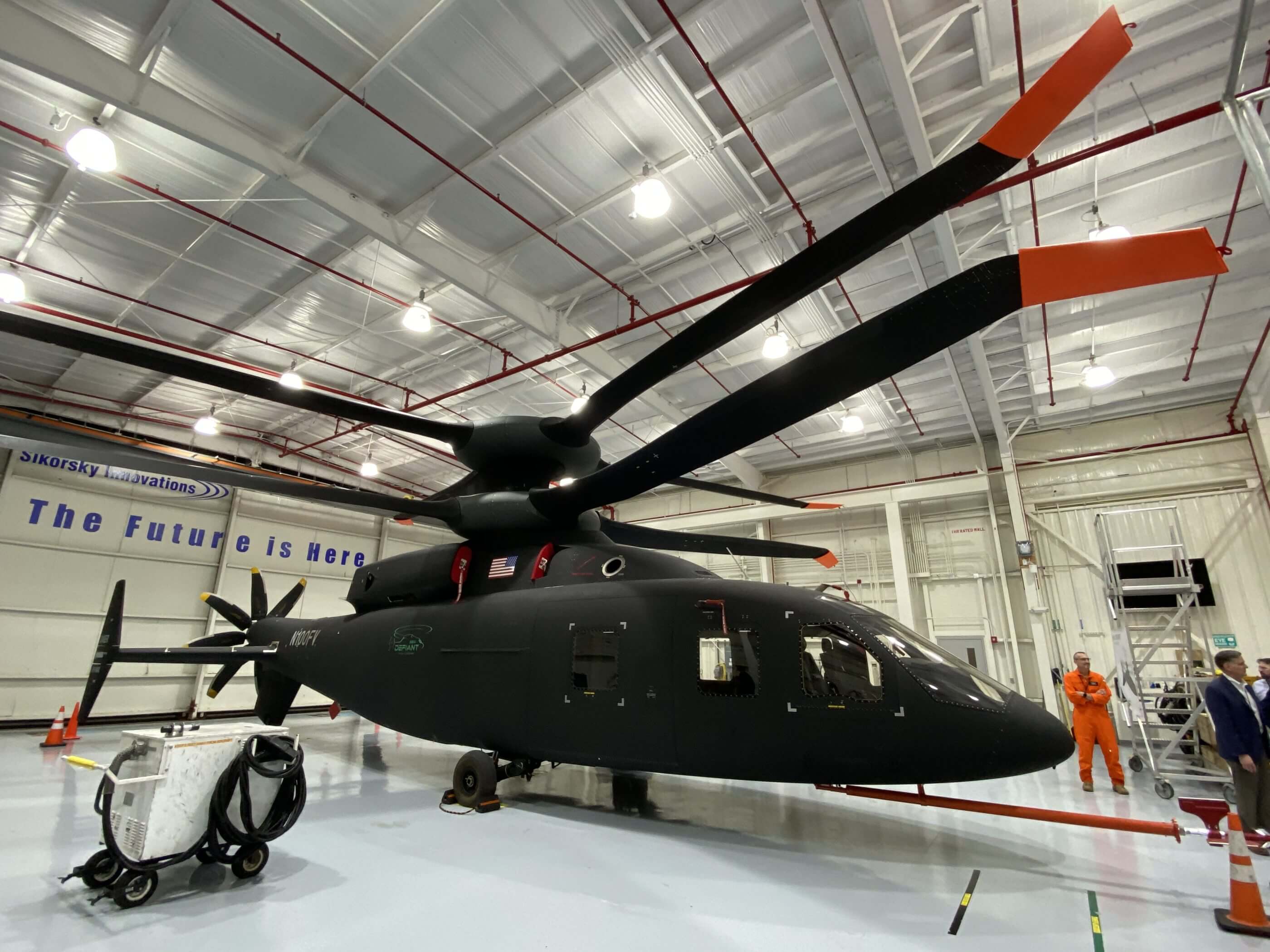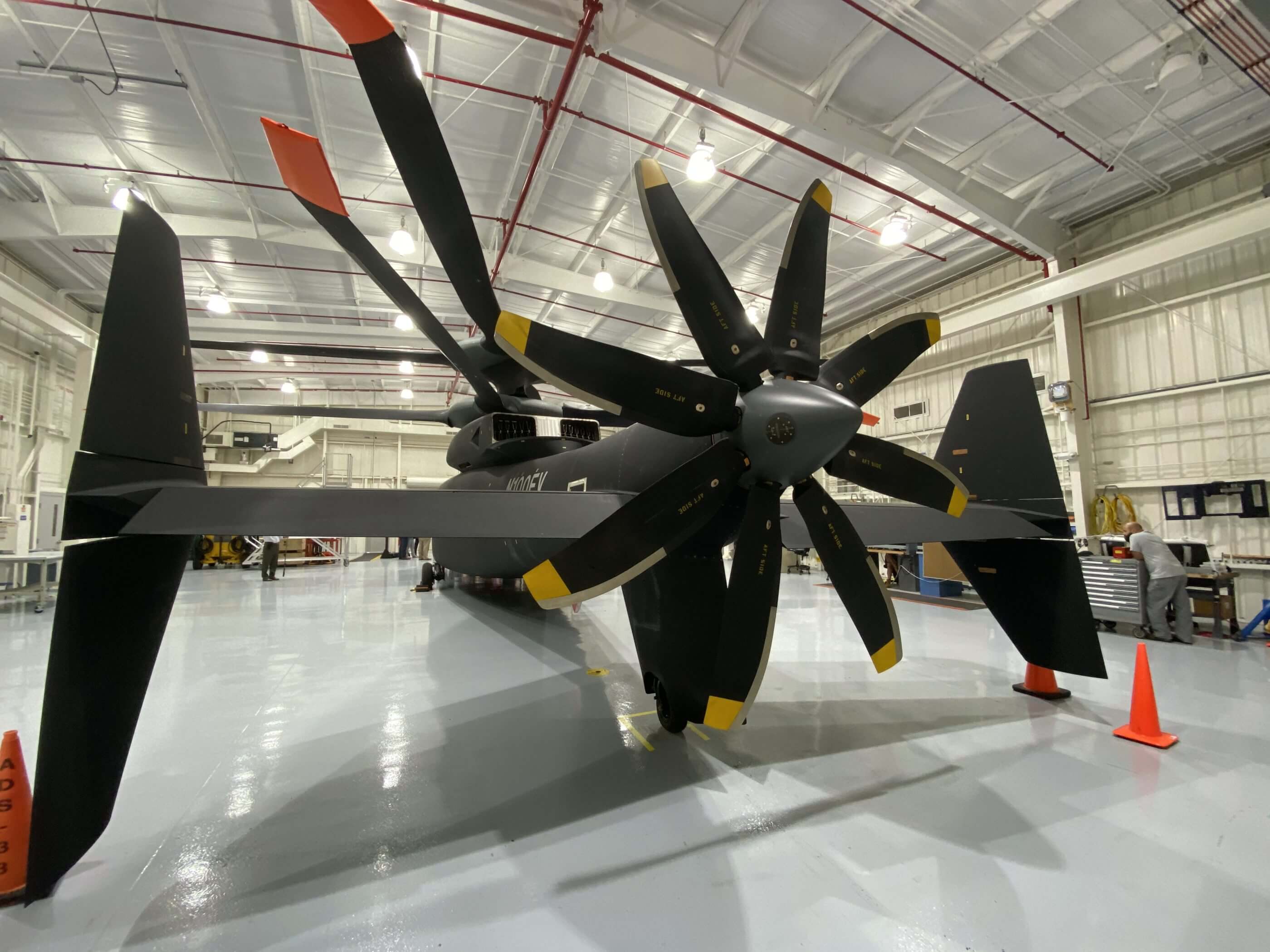Imagine flying into a combat zone and taking a direct hit that shattered the tail boom of the helicopter tasked with removing wounded troops from the field.
In any current configuration, that aircraft and everyone on it would be grounded, wounded themselves, or worse. The Sikorsky-Boeing SB>1 Defiant won’t have that problem, according to test pilots that have now taken the machine through 24 hours of flight time.

Defiant’s eight-bladed aft prop is the same diameter as a P-51 Mustang propeller and necessary to push the 30,000-pound aircraft to speeds above 200 knots. Unlike a conventional helicopter, none of Defiant’s tail section is flight critical. If the tail boom, which includes no hydraulics, took a direct hit and literally fell off, the aircraft would still be able to operate as a helicopter. All control surfaces aft of the engine outlet are controlled by electronic actuators.
“You can take significant combat damage back here,” Sikorsky test pilot Bill Fell said Feb. 20 during a media tour of the company’s West Palm Beach facility. “You lose the prop, you’re still a 150-knot machine. You lose the elevator, you’re still a 150-knot machine. The rudders aren’t even used in flight for yaw control below 90 knots. So, you still have a very capable machine.”
The coaxial compound helicopter has flown once every week in 2020, notching at least 24 hours of flight time not including the demonstration shown to Secretary of the U.S. Army Ryan McCarthy and reporters on Feb. 20. It was up against the Bell V-280 Valor advanced tiltrotor in the Joint Multirole Technology Demonstration (JMR-TD) program.
In developing the X2 technology that resulted in the 260-knot compound helicopter now in the Smithsonian Air and Space Museum, Sikorsky established that counter-rotating rotor blades could eliminate the retreating blade stall phenomenon.
“We have conquered the beast,” said Sikorsky President Dan Schultz said of rotor blade stall. That should allow the aircraft to achieve speeds above 280 knots.
First impression of Defiant is that it’s huge. Its dual main rotors are substantial and the fuselage is beefier than a UH-60. But the aircraft fits more or less within the same footprint as a Black Hawk. It is six inches taller and two feet wider than the aircraft Sikorsky is seeking to replace, but shorter head to tail than the legacy aircraft.
“It’s not that different than when we went from Hueys to Black Hawks,” Rotte said. “They weren’t that different in size, but a whole lot more capability. This is not that different in operational size, but a ton more capability.”
In all respects Defiant handles and flies much like its smaller cousin the S-97 Raider, which Sikorsky is developing into an offering for the Army’s Future Attack Reconnaissance Aircraft (FARA). Defiant is in line to replace the Black Hawk as the Army’s Future Long-Range Assault Aircraft (FLRAA).
Acronyms aside, Boeing and Sikorsky test pilots are enamored with Defiant.
“It flies like a helicopter but you’ve got this added element of maneuver capability,” Fell said. “It does not fly like a big aircraft. The rigidity in the rotor systems, as well as the responsiveness of the flight controls and the ease of flying the machine allows you to operate it as though it is a much smaller machine.”
There are no circuit breakers in the cockpit, which is instead fitted with solid-state electronic power controllers. The prop is controlled with a “beeper” on the collective that increases or decreases thrust. There also is a prop-engage button.
“The handling qualities are really predictable,” he said. “The beauty of the machine is it behaves exactly like you would expect. . . . I don’t think we’ll have any trouble with a 200- to 500-hour aviator right out of flight school teaching them to fly it. . . . On top of that, our companies have advanced flight controls being developed and in the can that are going to be able to be injected into the system to provide very, very high-level flying qualities.”

Defiant’s configuration features two side doors that are larger than those on a UH-60, providing plenty of space for a dozen troops to hop aboard and exit or to place litters with wounded onboard. The rigid rotors produce significant downwash but not noticeably more powerful than a Black Hawk.
“Downwash is a function of the gross weight of the machine and the diameter of the rotor system,” Fell said. “Compared to a Black Hawk, it’s a little bit higher. Compared to something with a much smaller rotor that tilts, it’s a lot less.”
Rotor rigidity also makes for no low spots in the rotor disc area. When the aft prop is disengaged, vehicles and troops can approach the aircraft safely from any direction.
“The height of the lower rotor, the inherent stiffness of the blades, coupled with the ability to stop the prop, basically makes safe 360-degree ingress and egress and I don’t know that there is another helicopter in the fight that can say that in any country,” he said.
That rigid rotor system makes the aircraft respond to control inputs more like a fighter jet than a helicopter with a teetering or articulated rotor system. Where the Black Hawk main rotor system is comprised of 450 parts, the Defiant has just over 200, simplifying its performance, responsiveness and reducing maintenance requirements.
“Helicopter pilots who started out their careers flying the UH-1 Huey or the OH-58, those are teetering rotor systems, as opposed to a Black Hawk or Apache . . . and when you jumped to an articulated system they had a sense of ‘Wow, this is a really sporty machine.’ They’re going to get a similar jump when they go for the articulated rotor system to this rigid rotor system. It’s more like a fighter jet response than a helicopter.”









